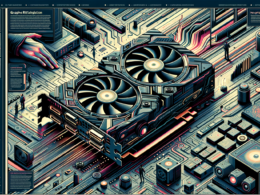Introduction to Cloud Gaming Evolution
In a significant development for the cloud gaming industry, Nvidia’s GeForce Now service is set to enhance its capabilities by integrating RTX 5080 GPUs. This latest advancement unveils a new era of performance and gaming possibilities for players worldwide. Nvidia’s move underscores the evolution and growing prevalence of cloud-based gaming, a trend propelled by technological advancements in graphics processing and internet infrastructure.
Zooming In
New Hardware and Enhanced Features
Power of RTX 5080
Scheduled for rollout in September, the Nvidia GeForce Now will introduce the Blackwell GPUs, equivalent to the RTX 5080, featuring an impressive 48GB of memory. At a subscription cost of $20 per month, users can harness this power to stream near-maxed-out PC games across various devices including smartphones, laptops, Chromebooks, and TVs.
Introducing Install-to-Play
One of the most compelling features accompanying this upgrade is the “Install-to-Play” mechanism. This capability allows players to install games directly, sidestepping Nvidia’s curation process. As a result, the GeForce Now library is anticipated to double instantly, providing gamers with access to a broader range of titles.
Instant Access Across Platforms
Currently, the Steam platform is the only one compatible with Install-to-Play. Nvidia’s Director of Product Marketing, Andrew Fear, highlighted the immediate availability of 2,352 games, emphasizing the seamless integration of Valve’s Steam Cloud Play feature. This development indicates an increasing trend of multi-platform accessibility, spurred by collaborations with various game publishers.
Enhanced Gaming Experience
Superior Streaming Options
Complimenting the hardware upgrades are enhanced streaming options. Nvidia will now allow users to stream in resolutions as high as 5K at 120 frames per second (fps), or up to 360fps at 1080p, contingent on sufficient bandwidth. This offers a significant leap in visual performance and responsiveness, critical for immersive gaming experiences.
Cinematic Quality Streaming
Nvidia introduces a Cinematic Quality Streaming mode, which reduces color bleed and enhances clarity in streamed images. This uses HDR10 and SDR10 formats with YUV 4:4:4 chroma sampling and an AV1 stream supplemented by AI video filtering. Such enhancements cater to gamers demanding superior visual fidelity.
Implications for the Gaming Ecosystem
Impact on Gamers and the Industry
The inclusion of RTX 5080 GPUs in GeForce Now aligns with broader industry trends towards more robust, accessible gaming experiences. Cloud gaming has become increasingly relevant, offering an alternative to traditional console or PC-based gaming. This upgrade can democratize access to high-quality gaming, reducing dependency on owning high-end hardware.
Competitive Landscapes
Nvidia’s advancements pose an interesting challenge to competitors like Google Stadia and Microsoft xCloud. With features like Install-to-Play and high-resolution streaming, Nvidia is setting new benchmarks for cloud gaming services, potentially influencing market dynamics.
Future Development
As Nvidia rolls out these new features, future enhancements might include broader platform compatibility and continuous expansion of their game library. Continuous partnerships with game developers could further strengthen their catalogue, ensuring a diverse selection of games.
Conclusion
Nvidia’s upgrades exemplify the rapid advancements within the cloud gaming sector, paving the way for enhanced gaming experiences. With initiatives like Install-to-Play and high-resolution streaming, Nvidia is not only elevating its service but also redefining expectations for cloud-based gaming. As cloud gaming continues to gain traction, these developments mark a pivotal point in its evolution, promising a rich and seamless gaming experience for a global audience.









